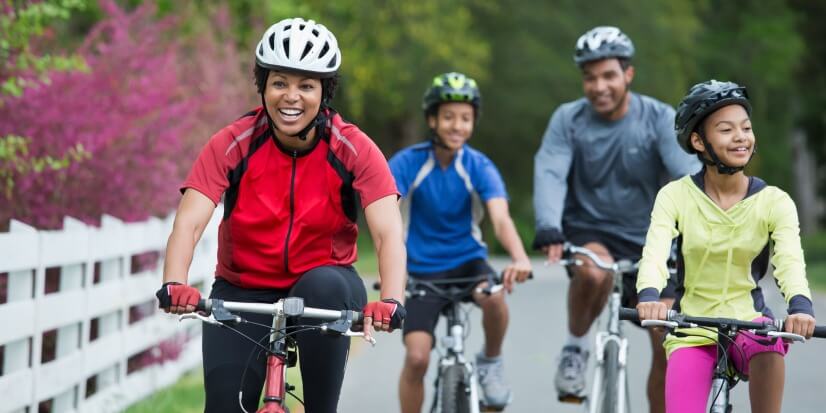Benefits of cycling
- Category: Healthy Living
- Posted on:

If a bicycle is your happy place, you’ll be glad to know the benefits of cycling abound. Beyond offering a mode of transportation (think cycling to work), bike riding provides a joint-friendly way to be physically active, which is important for your health in many ways.
Any activity that raises your heart rate and breathing rate is an aerobic activity, and aerobic exercises like riding a bike have been proven to reduce the risk of medical conditions like heart disease, stroke and diabetes.
Can I reap the health benefits of cycling in just 30 minutes a day?
Half an hour may not seem like much of a time commitment, but cycling for that length of time is a calorie burner, whether you’re riding outside or indoors cycling on a stationary bike.
You’ll use about 145 calories with 30 minutes of moderate cycling (slower than 10 mph) or around 295 calories with 30 minutes of intense cycling (faster than 10 mph), according to the American Academy of Family Physicians. All that calorie-burning movement reduces body fat, builds muscle, and can lead to a healthier body composition over time.
What body parts benefit from cycling?
Besides benefiting your entire body by circulating more oxygen throughout your heart, lungs and cardiovascular system, regular cycling also strengthens your abdominal core and works two of the largest muscles in your body—the quadriceps and gluteus maximus (your derriere). Daily cycling improves the tone of these engaged muscles.
Go all out for bike safety
Cycling is great for your health, but biking outdoors has its hazards. Cyclists protect themselves from injury by knowing and adhering to the rules of safe cycling and always wearing the appropriate safety gear, starting with a properly fitted bicycle helmet. Choose a helmet that:
- Sits evenly on your head.
- Allows no more than two fingers of space between the front lower edge of the helmet and your eyebrows
- Has side straps adjusted to form a “V” around your ears
- Has a chin strap adjusted to allow one finger of space between your chin and the strap when it’s buckled
Replace your helmet if the foam pad inside the helmet is worn or crumbling, you have an accident while wearing your helmet, your helmet gets damaged, or your helmet no longer fits.
Choosing bike paths that separate bikers from motorized vehicles—either by distance or with physical barriers—also provides a good measure of safety for cyclists. So does installing and wearing gear that helps motorists see you.
When riding during
One last important safety tip—don’t drink and cycle. Alcohol is a factor in about a third of accident-related cyclist deaths, according to the CDC.
Find your (bike) path
Looking for a place to bike outdoors? Check out these local cycling pathways:
Covington
Tammany Trace–A converted rail to trail headquartered in Mandeville, the Tammany Trace gives bike riders access to parks, wetlands and historic
Distance: 31 miles
New Orleans
French Quarter to the Lakefront Loop–This route
Distance: 15 miles
Lafitte Greenway–This greenway offers a wide, lit paved path for pedestrians and cyclists, with recreational parks and landscaping to enjoy along the way.
Distance: 2.6 miles
Uptown and Garden District Tour–If you’re comfortable biking in heavily trafficked areas, this route offers views of Audubon Park, beautiful homes, and manicured gardens and landscaping.
Distance: 7.2 miles
New Orleans/Kenner
Mississippi Levee-Top Trail/Audubon Zoo to Rivertown–Audubon Zoo marks the beginning of this paved trail, which also offers riders a view of the Mississippi River.
Distance: 11.7 miles
Learn more about the health benefits of regular exercise and discover four ways to create a heart-healthy lifestyle. Join the LCMC Health Weight Loss Krewe.

